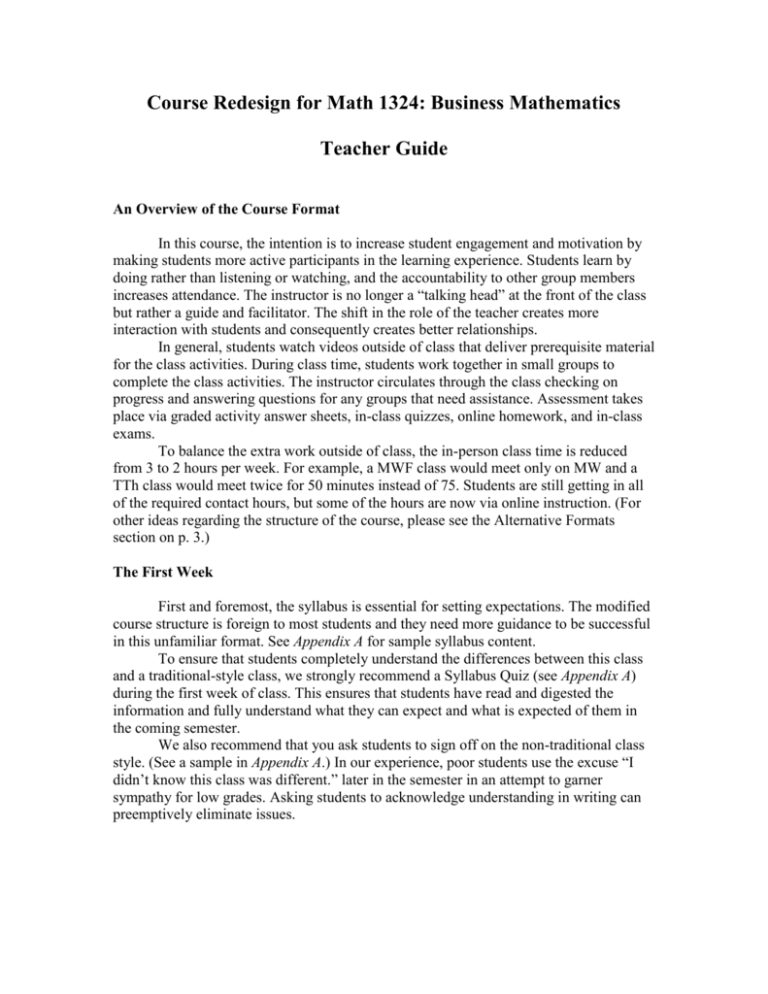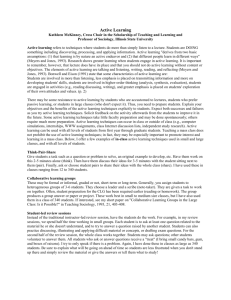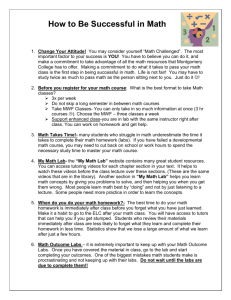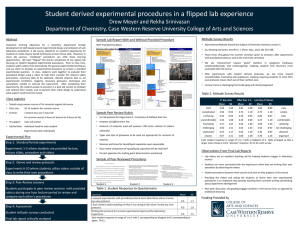Course Redesign for Math 1324: Business Mathematics Teacher
advertisement

Course Redesign for Math 1324: Business Mathematics Teacher Guide An Overview of the Course Format In this course, the intention is to increase student engagement and motivation by making students more active participants in the learning experience. Students learn by doing rather than listening or watching, and the accountability to other group members increases attendance. The instructor is no longer a “talking head” at the front of the class but rather a guide and facilitator. The shift in the role of the teacher creates more interaction with students and consequently creates better relationships. In general, students watch videos outside of class that deliver prerequisite material for the class activities. During class time, students work together in small groups to complete the class activities. The instructor circulates through the class checking on progress and answering questions for any groups that need assistance. Assessment takes place via graded activity answer sheets, in-class quizzes, online homework, and in-class exams. To balance the extra work outside of class, the in-person class time is reduced from 3 to 2 hours per week. For example, a MWF class would meet only on MW and a TTh class would meet twice for 50 minutes instead of 75. Students are still getting in all of the required contact hours, but some of the hours are now via online instruction. (For other ideas regarding the structure of the course, please see the Alternative Formats section on p. 3.) The First Week First and foremost, the syllabus is essential for setting expectations. The modified course structure is foreign to most students and they need more guidance to be successful in this unfamiliar format. See Appendix A for sample syllabus content. To ensure that students completely understand the differences between this class and a traditional-style class, we strongly recommend a Syllabus Quiz (see Appendix A) during the first week of class. This ensures that students have read and digested the information and fully understand what they can expect and what is expected of them in the coming semester. We also recommend that you ask students to sign off on the non-traditional class style. (See a sample in Appendix A.) In our experience, poor students use the excuse “I didn’t know this class was different.” later in the semester in an attempt to garner sympathy for low grades. Asking students to acknowledge understanding in writing can preemptively eliminate issues. Lecture Videos Before each class period, students have a video lecture assignment. The content in the assignment includes prerequisite material for the class activity, material that is never discussed in class, or a combination of the two. The video assignment also includes optional videos that repeat the same material as the activities, which students may use as extra preparation for class or as a review after class to follow up on the day’s material. Each video has built-in comprehension-check questions. The questions are the same difficulty level as those an instructor might ask in class during a traditional lecture, i.e, “What happens next?” or “Which technique should we use in this example?” as well as some True/False and simple math exercises. If you wish to record grades for the questions embedded in the video to ensure that students are actively watching, you can create video assignments with an online course management system. One example is WebAssign but any SCORM compliant system will work. If you do not wish to record grades for the videos, versions are available that give students immediate feedback on the embedded questions and are independent of any online course management system. The videos were created with PowerPoint and Camtasia and the content for the entire semester exists in video format. The original PowerPoint slides are available in pdf format for students to use as a notetaking tool. Group Work Students spend class time working in small groups on learning activities instead of listening to a lecture. Groups consist of three students who are randomly assigned to work together during the first week of the semester. Groups may need to be reorganized at some point in the semester to account for drops or adds. Due to absences, a group of one student may be temporarily merged with another small group for that day’s activity. You may also wish to reassign groups that are not functioning properly. There are a number of methods to randomly assign students to groups. For example, you may use a computer or spreadsheet program or assign students a group number as they come in to class one day. We recommend against letting students choose their own groups as this puts quiet students at a disadvantage and groups comprised of friends tend to chat more and work less. Students may wish to give their group a name, which introduces an element of fun and can build team unity. We found it most appropriate to let students choose group names from a list of math terms. Because students do not choose the groups, it is important to have measures in place to deal with problem groups. We suggest implementing a system by which students can reprimand or eject problem members. A Letter of Intent to Disassociate and a Letter of Disassociation are available in Appendix B and describe the procedures by which a group may deal with an unproductive member. Class Time Begin class with a warm-up exercise or a brief introduction connecting the required videos to the upcoming activity. After the introduction, the class breaks into groups to work through the activity. The instructor circulates to clarify and answer questions and, as often as possible, answer questions with leading questions rather than direct answers. Groups that finish early should be encouraged to help other groups who are still working. Each student needs an individual copy of the activity to work from and keep but only one answer sheet per group needs to be turned in for grading. All members of the group receive the same grade except that group members who are not present should receive a grade of zero for that activity. The activities each require between 20 and 50 minutes. The length of the activity is included on the teacher’s cover page that accompanies each activity. About half of the activities are designed to require less than a 50-minute class period because a shorter activity leaves room for an in-class quiz or other assessment of the instructor’s choice. Exams may be incorporated as appropriate for the institution and do not need to be modified. The course redesign does not affect the composition or administration of exams. Alternative Formats The materials are very flexible and can be used in a number of other ways. Some instructors and students may miss the inclusion of traditional lecture. For those people, it is certainly a possibility to break class activities into smaller units and include some live lecture. Many activities have natural break points and the unfinished portions can be assigned as homework or left as an optional supplement. Other arrangements include showing videos during class time and assigning the activities as homework, meeting once per week for 75 minutes, or using the lectures for an online class. Online Course Management Systems As previously mentioned, videos and homework can be assigned and graded within any SCORM compliant online course management system. An online system also provides a natural calendar of assignments, which is helpful for students who may lose track. However, an online system is not required for the use of the course materials. Calculator Usage Materials were developed under the assumption that students have access to a non-CAS graphing calculator, specifically the TI-83 or 84. Many activities incorporate specific calculator instructions and all calculator procedures are supported by videos with step-by-step instructions. Support Materials In addition to the semester’s worth of lecture videos, there are also numerous resources available to support students’ progress. A variety of tutorial videos address common misconceptions and topics with which students typically struggle. For extra practice and alternative explanations, a bank of supplemental exercises with video solutions covers all course topics. The support materials are particularly useful when students are studying for exams or struggling with a particular concept. Appendix A Sample Syllabus Syllabus Quiz; Quiz Key Acknowledgement of Course Format Appendix B Letter of Intent to Disassociate Letter of Disassociation







